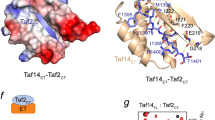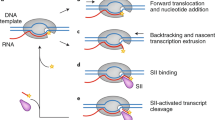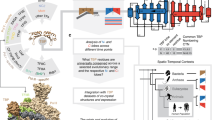Abstract
THE factor TFIID is one of several general factors that are necessary and sufficient for transcription initiation by mammalian RNA polymerase II1,2. Stable interactions with the common TATA element3,4 lead both to template commitment and to the assembly of the other general factors into a functional preinitiation complex5,6. Consistent with its key role in the promoter activation pathway, human TFIID also seems to be a target for some regulatory factors, as evidenced both by physical3,7,8 and functionall9–12 studies of interactions between these components. The evolutionary conservation of functional properties13,14 led to the purification and cloning of yeast TFIID15–19, the identification of presumptive structural motifs15,19, and direct structure–function studies20. Here we report the cloning of a complementary DNA encoding a functional human TFIID. This reveals an evolutionary conserved core which corresponds precisely to the 180-residue DNA binding/activation domain determined20 for yeast TFIID, a near absolute conservation of component structural motifs (direct repeats, central basic core/lysine repeat, and sigma homology), providing further support for their functional importance, and a unique N-terminal structure that suggests involvement in species-specific regulatory factor interactions.
This is a preview of subscription content, access via your institution
Access options
Subscribe to this journal
Receive 51 print issues and online access
$199.00 per year
only $3.90 per issue
Buy this article
- Purchase on Springer Link
- Instant access to full article PDF
Prices may be subject to local taxes which are calculated during checkout
Similar content being viewed by others
References
Matsui, T., Segall, J., Weil, P. A. & Roeder, R. G. J. biol. Chem. 255, 11992–11996 (1980).
Reinberg, D., Horikoshi, M. & Roeder, R. G. J. biol. Chem. 262, 3322–3330 (1987).
Sawadogo, M. & Roeder, R. G. Cell 43, 165–175 (1985).
Nakajima, N., Horikoshi, M. & Roeder, R. G. Molec. cell. Biol. 8, 4028–4040 (1988).
Van Dyke, M. W., Roeder, R. G. & Sawadogo, M. Science 241, 1335–1338 (1988).
Buratowski, S., Hahn, S., Guarente, L. & Sharp, P. A. Cell 56, 549–561 (1989).
Horikoshi, M., Hai, T., Lin, Y.-S., Green, M. R. & Roeder, R. G. Cell 54, 1033–1042 (1988).
Horikoshi, M., Carey, M. F., Kakidani, H. & Roeder, R. G. Cell 54, 665–669 (1988).
Workman, J. L. & Roeder, R. G. Cell 51, 613–622 (1987).
Abmayr, S. M., Workman, J. L. & Roeder, R. G. Genes Dev. 2, 542–553 (1988).
Workman, J. L., Abmayr, S. M., Cromlish, W. A. & Roeder, R. G. Cell 55, 211–219 (1988).
Workman, J. L., Roeder, R. G. & Kingston, R. E. EMBO J. 9, 1299–1308 (1990).
Buratowski, S., Hahn, S., Sharp, P. A. & Guarente, L. Nature 334, 37–42 (1988).
Cavallini, B. et al. Nature 334, 77–80 (1988).
Horikoshi, M. et al. Nature 341, 299–303 (1989).
Hahn, S., Buratowski, S., Sharp, P. A. & Guarente, L. Cell 58, 1173–1181 (1989).
Eisenmann, D. M., Dollard, C. & Winston, F. Cell 58, 1183–1191 (1989).
Schmidt, M. C., Kao, C. C., Pei, R. & Berk, A. J. Proc. natn. Acad. Sci. U.S.A. 86, 7785–7789 (1989).
Cavallini, B. et al. Proc. natn. Acad. Sci. U.S.A. 86, 9803–9807 (1989).
Horikoshi, M., Yamamoto, T., Ohkuma, Y., Weil, P. A. & Roeder, R. G. Cell 61, 1171–1178 (1990).
Hoffmann, A., Horikoshi, M., Wang, C. K., Schroeder, S., Weil, P. A. & Roeder, R. G. Genes Dev. 4, 1141–1148 (1990).
Gasch, A., Hoffmann, A., Horikoshi, M., Roeder, R. G. & Chua, N.-H. Nature 346, 390–394 (1990).
Courey, A. J. & Tjian, R. Cell 55, 887–898 (1988).
Suzuki, Y., Nogi, Y., Abe, A. & Fukasawa, T. Molec. cell. Biol. 8, 4991–4999 (1988).
Payne, J. M., Laybourn, P. J. & Dahmus, M. E. J. biol. Chem. 264, 19621–19629 (1989).
Mitchell, P. J. & Tjian, R. Science 245, 371–378 (1989).
Gerster, T., Balmaceda, C. G. & Roeder, R. G. EMBO J. 9, 1635–1643 (1990).
Scheidereit, C. et al. Nature 336, 551–557 (1988).
Sawadogo, M. & Roeder, R. G. Proc. natn. Acad. Sci. U.S.A. 82, 4394–4398 (1985).
Author information
Authors and Affiliations
Rights and permissions
About this article
Cite this article
Hoffmann, A., Sinn, E., Yamamoto, T. et al. Highly conserved core domain and unique N terminus with presumptive regulatory motifs in a human TATA factor (TFIID). Nature 346, 387–390 (1990). https://doi.org/10.1038/346387a0
Received:
Accepted:
Issue Date:
DOI: https://doi.org/10.1038/346387a0
This article is cited by
-
Regulation of the RNA polymerase II pre-initiation complex by its associated coactivators
Nature Reviews Genetics (2023)
-
50+ years of eukaryotic transcription: an expanding universe of factors and mechanisms
Nature Structural & Molecular Biology (2019)
-
COPASAAR – A database for proteomic analysis of single amino acid repeats
BMC Bioinformatics (2005)
-
SCA17 caused by homozygous repeat expansion in TBP due to partial isodisomy 6
European Journal of Human Genetics (2003)
-
Different types of repeat expansion in the TATA-binding protein gene are associated with a new form of inherited ataxia
European Journal of Human Genetics (2001)
Comments
By submitting a comment you agree to abide by our Terms and Community Guidelines. If you find something abusive or that does not comply with our terms or guidelines please flag it as inappropriate.



